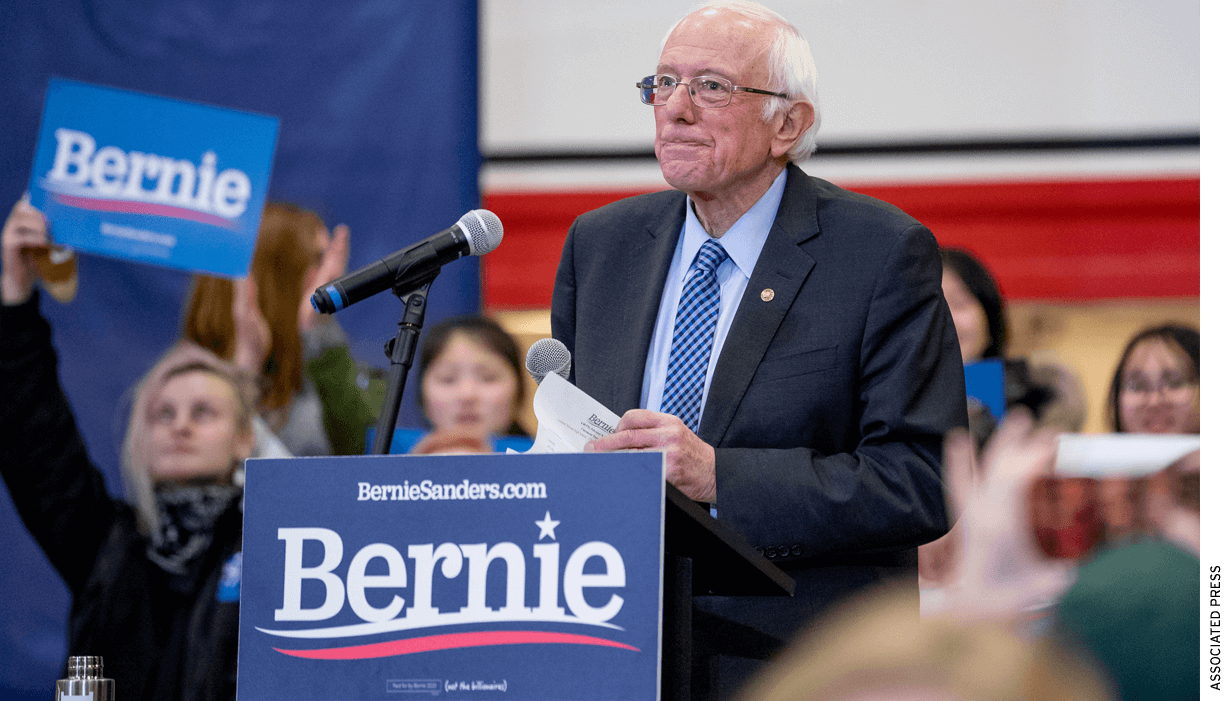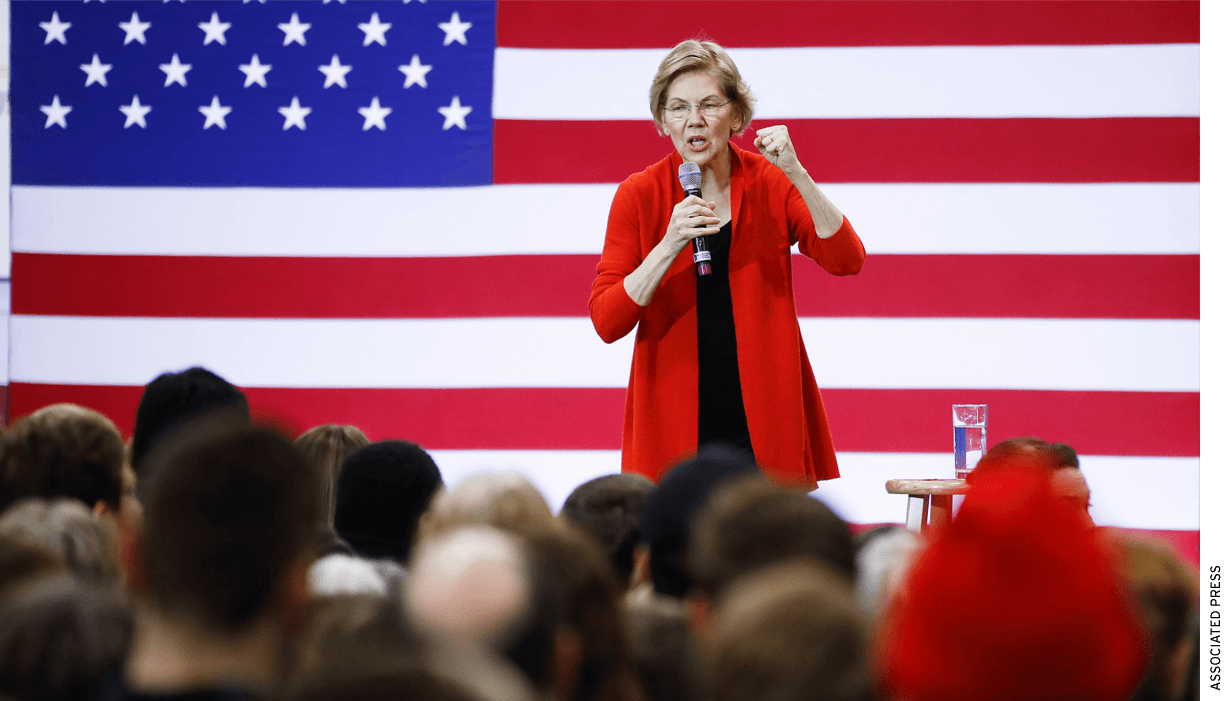
Bernie Sanders and Elizabeth Warren share remarkably similar policy platforms, including on education, but their campaigns for the Democratic nomination are trending in opposite directions. Two recent campaign rallies in New Hampshire suggest an explanation why.
At a campaign event in Claremont, New Hampshire, earlier this week, two days before that state’s first-in-the nation primary, in front of a standing room audience of nearly 600 people, Sanders made the case for his brand of democratic socialism. Less than two hours later, just 30 minutes north in Lebanon, before a similarly large and enthusiastic group of supporters, Elizabeth Warren held her own rally touting a similar progressive agenda. Two days later, Sanders won the New Hampshire primary with 25% of the vote, adding nine more delegates, and cementing his status as the current frontrunner for the Democratic nomination. Warren, in contrast, finished a disappointing 4th with only 9% of the vote, earned no delegates, and stoked speculation regarding her viability going forward.
What explains the different trajectories of their campaigns? It doesn’t seem to be policy. As both rallies made clear, the two candidates espouse remarkably similar agendas on issues ranging from Medicare-for-All to a higher minimum wage to increased taxes on the wealthy. For example, consider their stances on education. At the Claremont rally, Sanders spent a significant portion of his speech on this issue, beginning with his call to address “a dysfunctional childcare system” that disadvantages working families seeking affordable childcare. He then segued into a discussion of teacher pay: “In a country where we can give baseball players hundreds of millions of dollars … we can pay teachers at least $60,000 a year” in order to attract “the best and the brightest.”
After asking a young student behind him on stage if she was going to do well in school, Sanders touted his plan for free tuition to public colleges for those who qualify academically “regardless of family income.” Sanders framed this as a necessary extension of the current K-12 public school system if American students are to compete in a global economy. He then turned to his plan to forgive college student debt. “The crime you committed,” he said sarcastically after asking those holding debts to raise their hands, “is that you thought it was important to have a higher education…and you’re being punished for that for decades!” Again and again, Sanders urged his followers to ignore pundits and those in Congress, and instead to “think outside the box” regarding what can be done.

An hour later, Warren espoused almost identical education policies at her Lebanon rally. Unlike Sanders, she also added a personal touch, beginning her speech by reminding the audience that she knew since second grade that she wanted to be a public-school teacher. As a child she would pretend to teach her dolls – “I was tough but fair” she said to laughter. Despite a lack of financial resources, she won a scholarship to attend college, but dropped out to get married. However, she later attended a community college that cost $50 a semester – a reminder, she says, that the nation’s investment in public education “cracked open the door to opportunity,” allowing her to “get in the fight.”
In contrast to Sanders, Warren tends to limit her opening statements at campaign rallies to biographical details, and instead uses the question-and-answer session as a means to expound on policy. This was the pattern she followed in Lebanon. When an elementary school student told Warren about her favorite teacher, Warren used the exchange to make the case for taxpayer-supported universal pre-K education, funded by her proposal for a wealth tax. “Some billionaires don’t like this tax…some are running for president” she said, to laughter. She then noted that she would spend $800 billion of the revenue generated by the wealth tax to fund public school programs, including boosting spending on Title I program for low-income students. Like Sanders, she advocated for free tuition for technical colleges, two-year colleges, and four-year colleges. She too promised to cancel student debt. Later, in response to a question about standardized testing in schools, Warren said she would “end high stakes testing” and added, to lengthy applause, that she would hire a Secretary of Education “who believes in public education.” Warren promised that her education secretary would have a teaching background in public education and would “believe in science.”
Given the two campaigns’ similar messages on education and other issues, why does Warren seem to be faltering while Sanders is, for now, the frontrunner for the nomination? One explanation is gender; there is lingering belief among some voters, perhaps colored by gender bias, that after Clinton’s unsuccessful run in 2016 a woman cannot beat Trump. Surveys show that Democratic voters are particular focused on nominating a candidate who can win the general election. That is the case in New Hampshire; according to exit polls, New Hampshire voters made clear by a two-to-one margin that they prioritized winning the presidency over nominating someone who shared their policy views.
Beyond the gender difference, however, it is also the case that Sanders is incredibly effective at embedding his proposals in a larger narrative, one that portrays his candidacy as the spearhead in a fight for basic human rights against greedy economic interests with a vested interest in maintaining the status quo. For example, after discussing his plan to eliminate student debt, he immediately juxtaposed that with a reminder that “eleven years ago, the crooks on Wall St. who…nearly destroyed this economy got a huge bailout,” adding “If we can bail out crooks on Wall St….we can cancel all student debt.” For Sanders, then, the issue is basic fairness.
To be sure, Warren also frames her brief on behalf of “big structural change”, including education reforms, as a fight against Washington, D.C.-based corruption. But hers is a more cerebral approach that seems to lack the same emotional punch that Sanders portrays in his depiction of a world dominated by economic villains. At one point in his Claremont speech, Sanders noted that in his office, they often debate “who is the biggest crook”: Wall Street, health insurance companies, or the pharmaceutical industry. “I think it’s the pharmaceutical industry,” he concludes before indicting them in their role causing the opioid crisis. Warren’s anti-corruption narrative has its own villains, but it doesn’t seem to resonate on an emotional level with voters to quite the same degree as do Sanders’ jeremiads.
The moral certitude with which Sanders conveys his message is particularly appealing to younger voters entering the workforce and an uncertain economic future. And because he has been advocating this economic populist message since entering politics as a small-town mayor in Vermont nearly four decades ago, he carries a stamp of authenticity that Warren, a former Republican, finds difficult to match. This is not to say that Warren is incapable of tapping into the anger that animates many Democratic voters. But there can be only one nominee, and in the battle for hearts and mind, Sanders—so far—is the first choice for leftward-tilting voters. It remains unclear if that leaves Warren any path to the Democratic nomination.
Matt Dickinson is a professor of political science at Middlebury College. His blog is Presidential Power.


